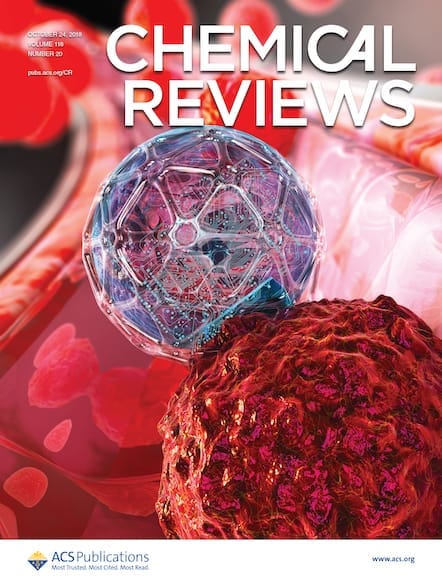In celebration of the journal's 100-year milestone, we bring you "Chemical Reviews Through the Decades," a curated selection of significant review articles published throughout the past century.

This year marks the 100th anniversary of Chemical Reviews. The journal launched its first issue in April of 1924, publishing four issues a year throughout its first decade. Now, 100 years later, Chemical Reviews publishes 24 issues per year, including 10 Collections.
The current Editor-in-Chief, Professor Sharon Hammes-Schiffer, has overseen the journal for the last eight years. As she reflects on the 100th anniversary, she notes, “It has been an honor to lead Chemical Reviews into a strong period of growth. We look forward to expanding the scope and content of the journal as we continue to provide comprehensive, authoritative, critical, and accessible reviews of recent research across all areas of chemistry.”
Chemical Reviews is an invite journal that encourages prospective authors to submit a Proposal. If the Proposal is accepted, the author will receive an invitation to submit a full Review. The journal considers submissions from a broad range of chemistry topics including, but not limited to, materials, nanoscience, synthesis, biological, environmental, Earth and space, physical, catalysis, and theoretical.
In celebration of the 100-year milestone, we have put together a curated selection, titled “Chemical Reviews Through the Decades,” highlighting articles of significance throughout the journal's history. Check back throughout the year as we continue to add new highlights to the collection!
Chemical Reviews Through the Decades
A Chemical Concept of the Origin and Development of Life. A Preliminary Presentation
Victor C. Vaughan
Chem. Rev. Volume 4, Issue 2 (1927)
Typical of the period, this Review by Victor C. Vaughan contains no data, no figures, and cites a total of six sources. The writing style, in which the author openly promotes his own opinions on the field, feels more at home in today's editorials than in a review article. Yet for all that, this review on the chemical origin of life raises issues that are still being discussed today. "How can we differentiate between non-living and living matter?" asks Vaughan. Scientists are still searching for the answer. Read the full Review.
The New Quantum Mechanics
J. H. Van Vleck
Chem. Rev. Volume 5, Issue 4 (1929)
After two decades of attempts to treat quantum mechanics as simply a correction to classical results, scientists in the late 1920's were ready to admit that these theories provided a completely new way of looking at the world. J. H. Van Vleck brought this "new" quantum mechanics to the American chemistry community in his 1929 review, and even at this early point Van Vleck could see the promise of the field. Van Vleck himself would be one of the drivers of this quantum revolution, and he received the Nobel Prize in Physics in 1977, 48 years after he penned this article for Chemical Reviews. Read the full Review.
Bonding Power of Electrons and Theory of Valence
Robert S. Mulliken
Chem. Rev. Volume 9, Issue 3 (1931)
Chemical bonding is such a fundamental concept that it's easy to take it for granted, but it wasn't always so. Robert Mulliken laid out many of the core principles for the then-new developments in the theory of valence in 1931. He would go on to win the Nobel Prize in Chemistry in 1966. Read the full Review.
Surface Chemistry
Irving Langmuir
Chem. Rev. Volume 13, Issue 2 (1933)
In 1932, Irving Langmuir became just the second American to win the Nobel Prize in Chemistry, for his contributions to surface chemistry. He summarized this new field here in 1933. Langmuir's work was influential for generations of chemists in the United States and around the world, and the ACS Publications journal Langmuir continues to publish the latest research on surface chemistry to this day. Read the full Review.
The Development of Combustion Research and the Present Outlook
Bernard Lewis
Chem. Rev. Volume 21, Issue 2 (1937)
This article kicked off a two-issue collection of reviews on combustion chemistry in 1937. The timing is notable; a few short years after later the world would be plunged into war, and the detailed measurements of combustion rates collected here would be used to develop the planes, tanks, ships, and bombs that the United States would field in Europe and the Pacific. This collection also represents a shift in the role of chemistry in society. Read the full Review.
A Review of Some Recent X-ray Work on Protein Crystals
Dorothy Crowfoot
Chem. Rev. Volume 28, Issue 2 (1941)
This review is also notable for being one of the earliest Chemical Reviews articles written by a woman. Dorothy Crowfoot would contribute to a number of key protein structure determinations over the next thirty years, and become the third woman to win the Nobel Prize in Chemistry in 1969. Read the full Review.
The Photovoltaic Effect
A. Wallace Copeland, Otis D. Black, and A. B. Garrett
Chem. Rev. Volume 31, Issue 1 (1942)
We think of solar energy as a new thing, but this 1942 shows that the promise of endless electrical power from sunlight has been with us for a long time. The specifics have changed quite a bit, though: the forebearers of today's silicon solar cells wouldn't be developed for another decade. Read the full Review.
Intermolecular interactions from a natural bond orbital, donor-acceptor viewpoint
Alan E. Reed, Larry A. Curtiss, and Frank Weinhold
Chem. Rev. Volume 88, Issue 6 (1988)
As Van Vleck predicted in 1929, quantum chemisty would become a powerful tool for analyzing chemical reactions. A number of different basis sets, such as the Natural Bond Orbitals approach presented here, were developed to access complicated systems with finite computers. These basis sets would become essential tools for chemists; this particular review has been cited almost 16,000 times. Read the full Review.
Environmental Applications of Semiconductor Photocatalysis
Michael R. Hoffmann, Scot T. Martin, Wonyong Choi, and Detlef W. Bahnemann
Chem. Rev. Volume 95, Issue 1 (1995)
The 1990's were a time of growing awareness of the toll that advances in technology and industry were taking on the planet. The chemical enterprise responded, as researchers shifted from how to create new products to how to clean up the old ones. Read the full Review.
Gold Nanoparticles: Assembly, Supramolecular Chemistry, Quantum-Size-Related Properties, and Applications toward Biology, Catalysis, and Nanotechnology
Marie-Christine Daniel and Didier Astruc
Chem. Rev. Volume 104, Issue 1 (2004)
At the turn of the millennium, nanotechnology had captured the public imagination. While neither the most hopeful imaginings of nanopowered robots nor the most dire fears of "grey goo" have come to pass, work in this area has opened up new possibilities for chemists. Gold nanoparticles have been particularly fruitful, with a wide array of applications. Read the full Review.
Learn More about Chemical Reviews

